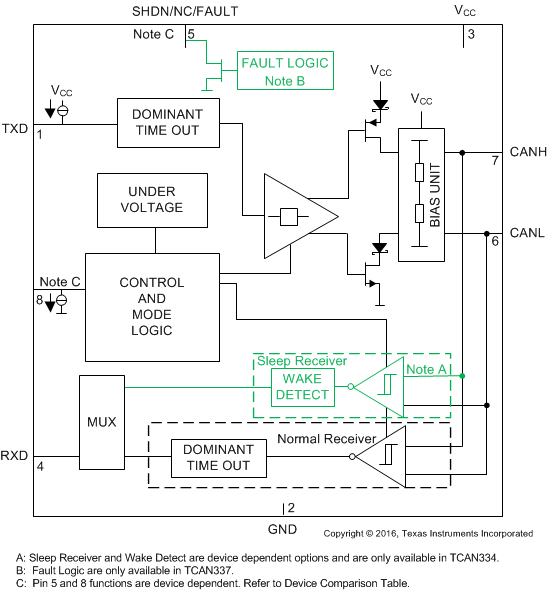SLLSEQ7E December 2015 – December 2019 TCAN330 , TCAN330G , TCAN332 , TCAN332G , TCAN334 , TCAN334G , TCAN337 , TCAN337G
PRODUCTION DATA.
- 1 Features
- 2 Applications
- 3 Description
- 4 Revision History
- 5 Description (continued)
- 6 Device Options
- 7 Pin Configuration and Functions
- 8 Specifications
- 9 Parameter Measurement Information
- 10Detailed Description
- 11Application and Implementation
- 12Power Supply Recommendations
- 13Layout
- 14Device and Documentation Support
- 15Mechanical, Packaging, and Orderable Information
Package Options
Mechanical Data (Package|Pins)
Thermal pad, mechanical data (Package|Pins)
- DCN|8
Orderable Information
3 Description
The TCAN33x family of devices is compatible with the ISO 11898 High Speed CAN (Controller Area Network) Physical Layer standard. TCAN330, TCAN332, TCAN334 and TCAN337 are specified for data rates up to 1 Mbps. Pending the release of the updated version of ISO 11898-2 including CAN FD, additional timing parameters defining loop delay symmetry are specified for the TCAN330G, TCAN332G, TCAN334G and TCAN337G devices. The devices include many protection features including driver and receiver Dominant Time Out (DTO) providing CAN network robustness. Integrated 12 kV IEC-61000-4-2 ESD Contact Discharge protection eliminates the need of additional components for system level robustness.
Device Information(1)
| PART NUMBER | PACKAGE | BODY SIZE (NOM) |
|---|---|---|
| TCAN330/G
TCAN332/G TCAN334/G TCAN337/G |
SOIC (8) | 4.90 mm × 3.91 mm |
| SOT-23 (8) | 2.90 mm x 1.60 mm |
- For all available packages, see the orderable addendum at the end of the data sheet.
Block Diagram
